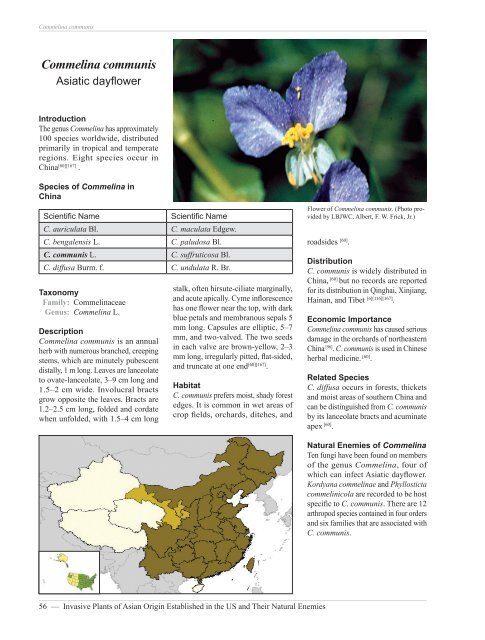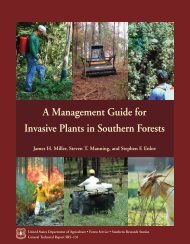Commelina communis
Commelina communis
Commelina communis
You also want an ePaper? Increase the reach of your titles
YUMPU automatically turns print PDFs into web optimized ePapers that Google loves.
<strong>Commelina</strong> <strong>communis</strong><strong>Commelina</strong> <strong>communis</strong>Asiatic dayflowerIntroductionThe genus <strong>Commelina</strong> has approximately100 species worldwide, distributedprimarily in tropical and temperateregions. Eight species occur inChina [60][167] .Species of <strong>Commelina</strong> inChinaScientific NameScientific NameC. auriculata Bl. C. maculata Edgew.C. bengalensis L. C. paludosa Bl.C. <strong>communis</strong> L. C. suffruticosa Bl.C. diffusa Burm. f. C. undulata R. Br.TaxonomyFamily: <strong>Commelina</strong>ceaeGenus: <strong>Commelina</strong> L.Description<strong>Commelina</strong> <strong>communis</strong> is an annualherb with numerous branched, creepingstems, which are minutely pubescentdistally, 1 m long. Leaves are lanceolateto ovate-lanceolate, 3–9 cm long and1.5–2 cm wide. Involucral bractsgrow opposite the leaves. Bracts are1.2–2.5 cm long, folded and cordatewhen unfolded, with 1.5–4 cm longstalk, often hirsute-ciliate marginally,and acute apically. Cyme inflorescencehas one flower near the top, with darkblue petals and membranous sepals 5mm long. Capsules are elliptic, 5–7mm, and two-valved. The two seedsin each valve are brown-yellow, 2–3mm long, irregularly pitted, flat-sided,and truncate at one end [60][167] .HabitatC. <strong>communis</strong> prefers moist, shady forestedges. It is common in wet areas ofcrop fields, orchards, ditches, andFlower of <strong>Commelina</strong> <strong>communis</strong>. (Photo providedby LBJWC, Albert, F. W. Frick, Jr.)roadsides [60] .DistributionC. <strong>communis</strong> is widely distributed inChina, [60] but no records are reportedfor its distribution in Qinghai, Xinjiang,Hainan, and Tibet [6][116][167] .Economic Importance<strong>Commelina</strong> <strong>communis</strong> has caused seriousdamage in the orchards of northeasternChina [96] . C. <strong>communis</strong> is used in Chineseherbal medicine. [60] .Related SpeciesC. diffusa occurs in forests, thicketsand moist areas of southern China andcan be distinguished from C. <strong>communis</strong>by its lanceolate bracts and acuminateapex [60] .Natural Enemies of <strong>Commelina</strong>Ten fungi have been found on membersof the genus <strong>Commelina</strong>, four ofwhich can infect Asiatic dayflower.Kordyana commelinae and Phyllostictacommelinicola are recorded to be hostspecific to C. <strong>communis</strong>. There are 12arthropod species contained in four ordersand six families that are associated withC. <strong>communis</strong>.56 — Invasive Plants of Asian Origin Established in the US and Their Natural Enemies
<strong>Commelina</strong> <strong>communis</strong>FungiPhylum Family Species H. R. Ref.AscomycotaBasidiomycotaHyponectriaceae Physalospora commelinae Sawada mo 23Sclerotiniaceae Sclerotinia sclerotiorum (Lib.) de Bary po 23Atheliaceae Athelia rolfsii (Curzi) C.C. Tu & Kimbr. po 23 †Brachybasidiaceae Kordyana commelinae Sawada m 23Ceratobasidiaceae Thanatephorus cucumeris (A.B. Frank) Donk po 23 ‡Phakopsoraceae Phakopsora tecta H.S. Jacks. & Holw. oo 23PucciniaceaeUstilaginaceaePuccinia adhikarii Ono po 149Uromyces commelinae Cooke p 23Ustilago commelinae (Kom.) Zundelmo 23m 54Anamorphic Guignardia Phyllosticta commelinicola E. Young m 195†Recorded as Corticium centrifugum (Lév.) Bres.‡Recorded as Corticium sasakii (Shirai) Matsum.ArthropodsOrder Family Species H. R. Ref.mo 65Lema chujoi Gressitt et Kimotomo 139p 65Lema concinnipennis Balyp 139Lema coromandeliana (Fabricius) mo 139p 65CrioceridaeLema coronata Balyp 139Coleopteram 65Lema delicatula Balym 139p 65Lema diversa Balyp 139Lema scutellaris (Kraatz) m 139Eumolpidae Acrothinium gaschkevitschii (Motschulsky) p 139Hispidae Cassida piperata Hope po 140Hemiptera Pentatomidae Aeschrocoris ceylonicus Distant m 65m 65Homoptera Aphididae Aphis commelinae Shinjim 100po 206Lepidoptera Sphingidae Rhyncholaba acteus (Cramer)p 208Invasive Plants of Asian Origin Established in the US and Their Natural Enemies — 57

















